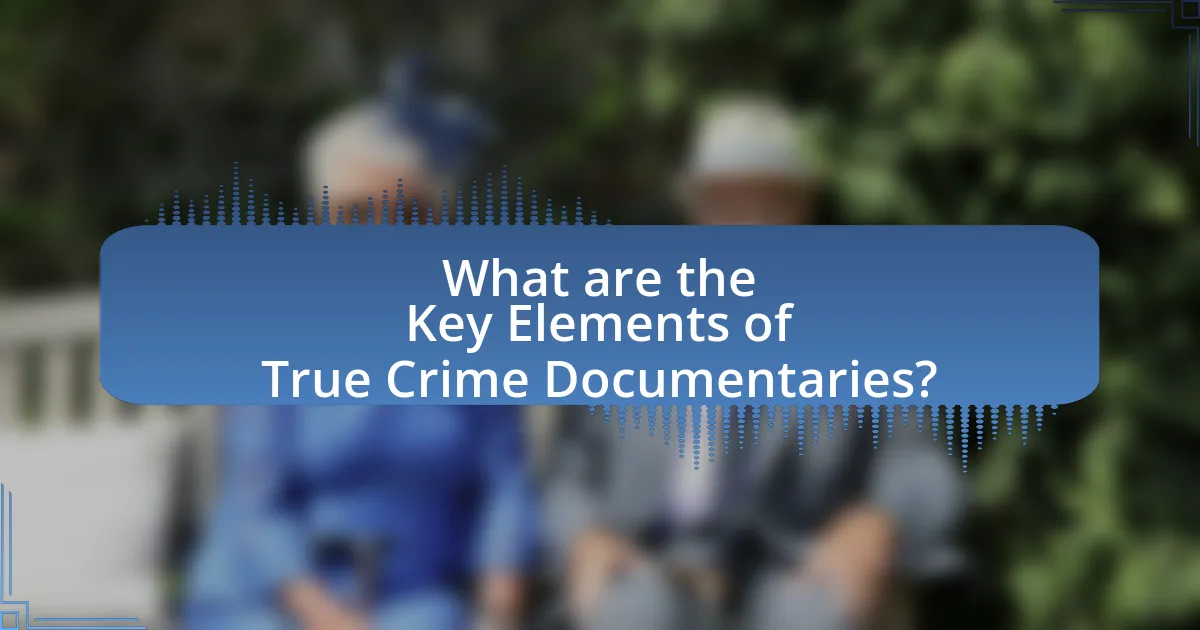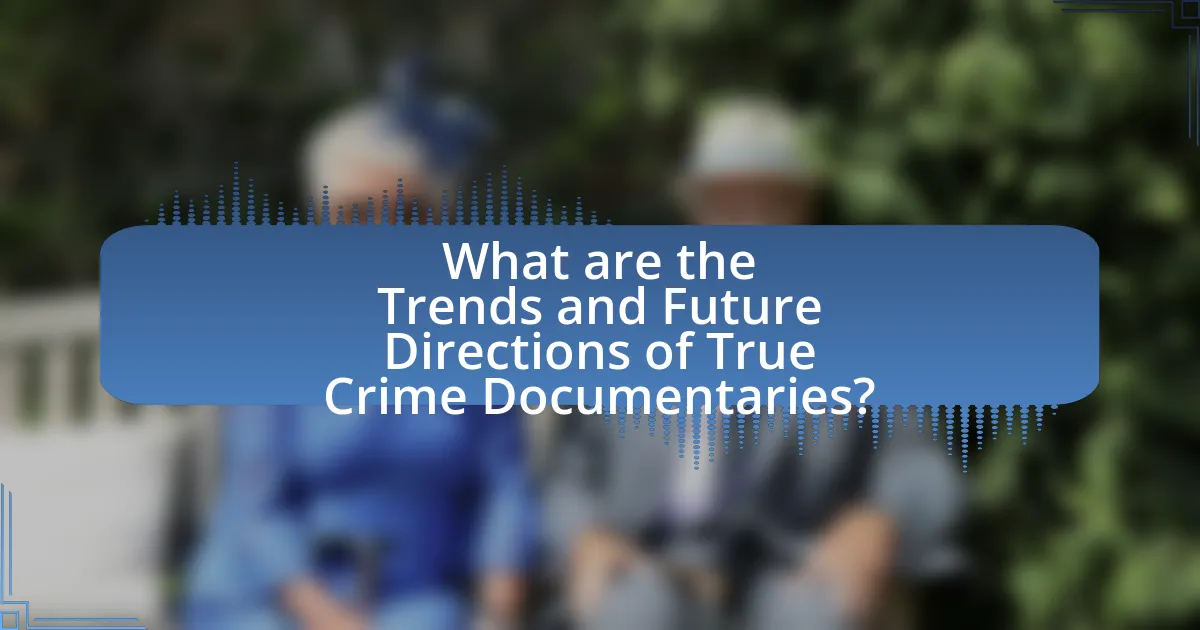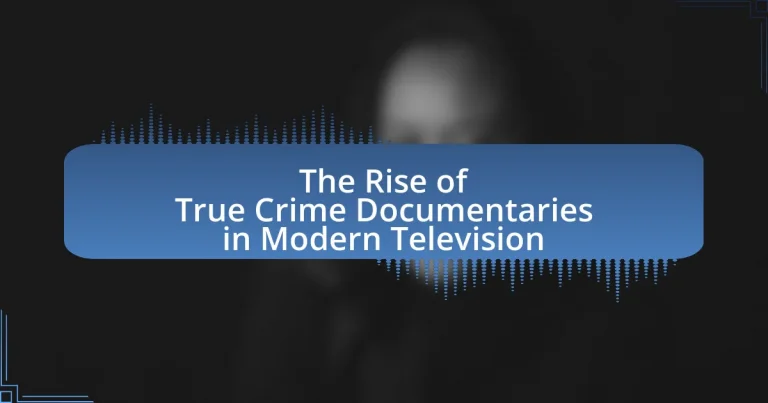True crime documentaries are non-fiction films or series that delve into real criminal cases, detailing investigations, trials, and their aftermath. Their popularity has surged due to a fascination with crime, psychological thrills, and emotional engagement with real-life stories, particularly on streaming platforms. The genre has evolved from simplistic reenactments to complex narratives that address psychological, social, and legal dimensions of crime, influenced by historical events and changing societal attitudes. Key elements include compelling storytelling, thorough research, and ethical considerations, while innovations in technology and audience interaction are shaping the future of true crime content.

What are True Crime Documentaries and Why are They Popular?
True crime documentaries are non-fiction films or series that explore real criminal cases, often detailing the investigation, trial, and aftermath of crimes. Their popularity stems from a combination of factors, including the human fascination with crime, the psychological thrill of understanding criminal behavior, and the emotional engagement that comes from real-life stories. According to a 2021 survey by Statista, 45% of respondents in the U.S. reported watching true crime content, indicating a significant audience interest. This genre also benefits from the rise of streaming platforms, which have made such content more accessible, further fueling its popularity.
How did True Crime Documentaries evolve over time?
True crime documentaries evolved significantly from their early origins in the 20th century to the present day, transitioning from simplistic crime reenactments to complex narratives that explore psychological, social, and legal dimensions of crime. Initially, true crime content was primarily presented through print media and sensationalized television segments, often focusing on notorious cases without in-depth analysis. The 1990s saw the emergence of more structured documentary formats, exemplified by series like “American Justice,” which began to incorporate interviews and expert commentary, providing a more nuanced view of criminal cases.
In the 2000s, the genre gained further traction with the advent of streaming platforms, allowing for serialized storytelling and deeper exploration of cases, as seen in “Making a Murderer,” which not only chronicled a specific case but also raised questions about the justice system. This shift was supported by audience demand for more engaging and thought-provoking content, leading to a boom in true crime programming. By the 2010s and beyond, true crime documentaries began to incorporate diverse perspectives, including those of victims’ families and communities, and often addressed broader societal issues such as systemic racism and mental health, reflecting a more comprehensive understanding of crime and its impact.
The evolution of true crime documentaries is marked by a shift from mere entertainment to a platform for social commentary, driven by advancements in technology and changing viewer expectations.
What historical events influenced the rise of True Crime Documentaries?
The rise of True Crime Documentaries was significantly influenced by several historical events, particularly high-profile criminal cases and societal shifts in media consumption. The O.J. Simpson trial in the 1990s marked a pivotal moment, as it captivated national attention and demonstrated the public’s fascination with crime narratives. Additionally, the advent of the internet and streaming platforms in the 2000s allowed for greater accessibility and demand for true crime content, leading to a surge in documentary production. The popularity of shows like “Making a Murderer” in 2015 further solidified the genre’s appeal, showcasing real-life legal battles and injustices, which resonated with audiences seeking both entertainment and insight into the criminal justice system.
How have societal attitudes towards crime shaped these documentaries?
Societal attitudes towards crime have significantly influenced the content and narrative style of true crime documentaries. As public interest in criminal behavior and justice has grown, these documentaries have evolved to reflect contemporary concerns, such as systemic injustice, mental health issues, and the impact of crime on communities. For instance, the rise of social media and the demand for transparency in law enforcement have led to documentaries that not only recount criminal cases but also critique the legal system and highlight the voices of marginalized victims. This shift is evidenced by the popularity of series like “Making a Murderer,” which sparked discussions about wrongful convictions and police misconduct, illustrating how societal perceptions can drive the focus and framing of true crime narratives.
What psychological factors contribute to the popularity of True Crime Documentaries?
The popularity of True Crime Documentaries is primarily driven by psychological factors such as curiosity about human behavior, the thrill of fear, and a desire for social connection. Curiosity about the darker aspects of human nature compels viewers to explore real-life crimes, as evidenced by studies indicating that people are inherently drawn to understanding the motivations behind criminal acts. The thrill of fear, often referred to as “benign masochism,” allows viewers to experience fear in a safe environment, providing an adrenaline rush without real danger. Additionally, True Crime Documentaries foster social connection by sparking discussions and shared experiences among viewers, which is supported by research showing that engaging with such content can enhance social bonding. These psychological factors collectively contribute to the sustained interest and popularity of the genre.
Why are viewers drawn to stories of crime and justice?
Viewers are drawn to stories of crime and justice due to their inherent intrigue and the psychological thrill they provide. These narratives often explore the complexities of human behavior, morality, and societal norms, allowing audiences to engage with themes of good versus evil. Research indicates that approximately 70% of adults in the U.S. express interest in true crime content, highlighting its widespread appeal. Additionally, the resolution of crime stories often offers a sense of closure and justice, which can be psychologically satisfying for viewers. This combination of fascination with the darker aspects of humanity and the desire for resolution contributes significantly to the popularity of crime and justice narratives.
How does the portrayal of criminals affect audience perception?
The portrayal of criminals significantly shapes audience perception by influencing their understanding of crime and the criminal justice system. When criminals are depicted as complex individuals with relatable backgrounds, audiences may develop empathy and a nuanced view of criminal behavior. Conversely, sensationalized portrayals can lead to fear and stigmatization, reinforcing stereotypes about certain groups. Research indicates that media representations can alter public attitudes toward crime; for instance, a study published in the Journal of Criminal Justice found that viewers of crime documentaries often perceive crime as more prevalent and dangerous than it is in reality. This skewed perception can affect public opinion on policies related to crime and punishment, highlighting the powerful role of media in shaping societal views.

What are the Key Elements of True Crime Documentaries?
The key elements of true crime documentaries include a compelling narrative, thorough research, expert interviews, and visual storytelling techniques. A compelling narrative engages viewers by presenting a clear and intriguing storyline, often focusing on a specific crime or criminal case. Thorough research ensures accuracy and credibility, often involving the examination of police reports, court documents, and other primary sources. Expert interviews with law enforcement officials, criminologists, or family members provide insights and context, enhancing the documentary’s depth. Visual storytelling techniques, such as reenactments, archival footage, and dramatic cinematography, create an immersive experience that captivates the audience. These elements collectively contribute to the effectiveness and popularity of true crime documentaries in modern television.
How do storytelling techniques enhance True Crime Documentaries?
Storytelling techniques enhance True Crime Documentaries by creating emotional engagement and providing a structured narrative that captivates viewers. These techniques, such as character development, suspense, and pacing, allow audiences to connect with the victims and the complexities of the cases. For instance, the use of real-life interviews and dramatizations helps to humanize the subjects, making the stories more relatable and impactful. Additionally, employing cliffhangers and narrative twists keeps viewers invested, as seen in popular series like “Making a Murderer,” which utilizes these elements to maintain tension and provoke discussion. This structured approach not only informs but also evokes empathy, making the content more compelling and memorable.
What role does narrative structure play in engaging the audience?
Narrative structure plays a crucial role in engaging the audience by providing a coherent framework that guides the viewer through the story. This structure helps to build suspense, develop characters, and create emotional connections, which are essential elements in true crime documentaries. For instance, a well-defined narrative arc, including exposition, rising action, climax, and resolution, keeps viewers invested in the unfolding events and encourages them to form opinions about the characters involved. Research indicates that viewers are more likely to remain engaged when the narrative structure effectively balances tension and resolution, as seen in successful true crime series like “Making a Murderer,” which utilizes a compelling narrative to maintain audience interest throughout its episodes.
How do visuals and reenactments contribute to the storytelling?
Visuals and reenactments enhance storytelling by providing a vivid representation of events, making narratives more engaging and relatable. They allow viewers to visualize complex scenarios, thereby deepening emotional connections to the subject matter. For instance, in true crime documentaries, reenactments can illustrate the sequence of events leading to a crime, helping audiences understand the context and motivations behind actions. Research indicates that visual elements can increase retention of information by up to 65%, as they cater to various learning styles and enhance comprehension. This integration of visuals and reenactments not only captivates viewers but also reinforces the narrative’s authenticity and impact.
What ethical considerations are involved in producing True Crime Documentaries?
Producing True Crime Documentaries involves several ethical considerations, primarily concerning the portrayal of victims and their families, the accuracy of information presented, and the potential for sensationalism. Ethical production requires sensitivity to the trauma experienced by victims and their loved ones, ensuring that their stories are told respectfully and without exploitation. Accuracy is crucial, as misrepresentation can lead to misinformation and harm to individuals’ reputations. Sensationalism can trivialize serious crimes, leading to public desensitization and a distorted understanding of criminal justice issues. These considerations are essential for maintaining integrity and responsibility in documentary filmmaking.
How do filmmakers balance sensationalism with factual reporting?
Filmmakers balance sensationalism with factual reporting by prioritizing accuracy while employing engaging storytelling techniques. They often conduct thorough research, utilizing primary sources such as court documents, interviews with law enforcement, and testimonies from victims or their families to ensure factual integrity. For instance, the documentary “Making a Murderer” combines detailed investigative journalism with dramatic narrative elements, which helps maintain viewer interest without sacrificing truth. This approach allows filmmakers to attract audiences while adhering to ethical standards in documentary filmmaking.
What impact do these documentaries have on real-life victims and families?
True crime documentaries significantly impact real-life victims and their families by raising awareness about their experiences and often leading to public discussions on unresolved cases. These documentaries can provide a platform for victims’ stories, potentially fostering empathy and understanding from the audience. For instance, the documentary “The Keepers” brought renewed attention to the unsolved murder of Sister Cathy Cesnik, leading to increased public interest and advocacy for justice. Additionally, families may experience a mix of emotions, including validation and distress, as their loved ones’ stories are shared, which can influence their healing process.

What are the Trends and Future Directions of True Crime Documentaries?
The trends and future directions of true crime documentaries indicate a growing emphasis on narrative complexity and viewer engagement. Recent data shows that audiences are increasingly drawn to series that not only present factual accounts but also explore psychological and sociocultural dimensions of crime, as evidenced by the success of productions like “Making a Murderer” and “The Jinx.” Furthermore, the integration of interactive elements, such as viewer polls and social media discussions, is becoming more prevalent, allowing audiences to participate in the storytelling process. This shift is supported by a 2022 survey from the Pew Research Center, which found that 65% of viewers prefer documentaries that encourage audience interaction. Additionally, the rise of streaming platforms has led to a diversification of content, with niche topics gaining traction, reflecting a broader interest in underrepresented stories within the true crime genre.
How has streaming changed the landscape of True Crime Documentaries?
Streaming has significantly transformed the landscape of True Crime Documentaries by providing greater accessibility and a wider variety of content. Platforms like Netflix, Hulu, and Amazon Prime have enabled the production and distribution of numerous true crime series, leading to a surge in viewer interest and engagement. For instance, Netflix’s “Making a Murderer” and “The Keepers” have attracted millions of viewers, demonstrating the power of streaming to reach global audiences. Additionally, streaming services allow for binge-watching, which enhances viewer immersion and retention, further solidifying the genre’s popularity. This shift has also encouraged creators to explore diverse narratives and innovative storytelling techniques, resulting in a richer and more varied true crime landscape.
What platforms are leading the charge in True Crime content?
Streaming platforms such as Netflix, Hulu, and HBO Max are leading the charge in True Crime content. Netflix has significantly invested in the genre, producing popular series like “Making a Murderer” and “The Keepers,” which have garnered millions of views and critical acclaim. Hulu has also made strides with titles like “The Act,” while HBO Max features compelling documentaries such as “I’ll Be Gone in the Dark.” These platforms dominate the True Crime landscape due to their extensive libraries, original programming, and ability to reach a global audience, making them key players in the rise of True Crime documentaries in modern television.
How does binge-watching affect viewer engagement with True Crime stories?
Binge-watching significantly enhances viewer engagement with True Crime stories by creating an immersive experience that encourages prolonged viewing sessions. This format allows viewers to develop a deeper emotional connection to the narratives and characters, as they can follow complex storylines without interruption. Research indicates that 70% of viewers prefer binge-watching for its ability to maintain suspense and emotional investment, which is particularly effective in True Crime genres where tension and resolution are critical to viewer satisfaction.
What innovations are emerging in the production of True Crime Documentaries?
Innovations in the production of True Crime Documentaries include the use of advanced technology such as augmented reality (AR) and virtual reality (VR) to create immersive storytelling experiences. These technologies allow viewers to engage with the narrative in a more interactive manner, enhancing emotional connection and understanding of the cases presented. Additionally, the integration of real-time data analytics helps producers tailor content to audience preferences, ensuring higher engagement rates. For instance, platforms like Netflix utilize viewer data to inform the direction of their true crime series, leading to more targeted and compelling storytelling.
How are new technologies influencing storytelling in True Crime?
New technologies are significantly influencing storytelling in True Crime by enhancing the accessibility and interactivity of narratives. For instance, advancements in streaming platforms allow for the release of serialized content, enabling deeper exploration of cases over multiple episodes, which engages viewers more thoroughly. Additionally, the use of data visualization tools and interactive graphics helps to present complex information, such as timelines and relationships between individuals, in a more digestible format. Furthermore, social media platforms facilitate real-time audience engagement, allowing viewers to discuss and analyze episodes as they air, which can influence the direction of future content. These technological innovations not only enrich the storytelling experience but also democratize the narrative, allowing for diverse perspectives and voices to be included in True Crime storytelling.
What role does audience interaction play in the future of True Crime Documentaries?
Audience interaction is pivotal in shaping the future of True Crime Documentaries by enhancing viewer engagement and influencing content direction. As audiences increasingly participate through social media platforms, their feedback and discussions can drive narrative choices, leading to more personalized and relevant storytelling. For instance, platforms like Netflix have utilized viewer ratings and comments to inform the development of new series, demonstrating that audience preferences can directly impact production decisions. This interactive dynamic not only fosters a sense of community among viewers but also encourages creators to address topics that resonate with their audience, ultimately making True Crime Documentaries more compelling and reflective of societal interests.
What are some best practices for creating impactful True Crime Documentaries?
To create impactful True Crime Documentaries, filmmakers should prioritize thorough research, compelling storytelling, and ethical considerations. Thorough research ensures accuracy and depth, as seen in successful documentaries like “Making a Murderer,” which utilized extensive interviews and court documents to present a nuanced view of the case. Compelling storytelling engages viewers emotionally; for instance, using a narrative arc that includes character development and conflict can enhance viewer investment. Ethical considerations are crucial, particularly in respecting the victims and their families, as highlighted by the backlash faced by some documentaries that sensationalized tragedies without sensitivity. By integrating these best practices, filmmakers can produce documentaries that resonate with audiences while maintaining integrity.
How can filmmakers ensure accuracy while maintaining viewer interest?
Filmmakers can ensure accuracy while maintaining viewer interest by employing thorough research methods and engaging storytelling techniques. By conducting in-depth investigations, filmmakers can gather factual information from credible sources, such as court documents, interviews with experts, and firsthand accounts from those involved in the events. For instance, the documentary “Making a Murderer” utilized extensive interviews and legal documents to present a detailed narrative while keeping viewers engaged through dramatic storytelling and cliffhangers. This combination of factual accuracy and compelling narrative structure not only informs the audience but also captivates them, demonstrating that accuracy and interest can coexist effectively in true crime documentaries.
What strategies can be employed to handle sensitive topics responsibly?
To handle sensitive topics responsibly, creators should prioritize accuracy, empathy, and context. Accuracy ensures that the information presented is factual and well-researched, which is crucial in true crime documentaries where misrepresentation can harm individuals and communities. Empathy involves understanding the emotional impact of the subject matter on victims, families, and viewers, fostering a respectful narrative that honors those affected. Context is essential to provide viewers with a comprehensive understanding of the events, avoiding sensationalism that can distort perceptions. For instance, studies show that responsible storytelling in media can lead to increased public awareness and sensitivity towards the issues presented, highlighting the importance of these strategies in true crime narratives.


